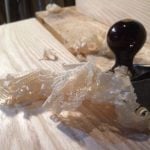finding quarter sawn white oak more difficult than pine was
Welcome! / Forums / Project Series / Wallclock / finding quarter sawn white oak more difficult than pine was
- This topic has 9 replies, 7 voices, and was last updated 5 years, 8 months ago by
joeleonetti.
-
AuthorPosts
-
8 February 2017 at 9:45 pm #309086
Hi,
I had made two clocks out of pine. Things went reasonably well and I learned a lot in the process. For the third wall clock build I thought I’d try making it from quarter sawn white oak. I’ve never worked in oak or any hardwood for that matter (been woodworking for about a year). Prior to starting I made sure all my tools were sharpened. I really enjoyed the dimensioning of the oak and cutting the big housing dados in the top and bottom. When it came time to make the grooves with the plough plane and the beading (i.e. the stuff needed for the front panel to eventually fit into), I was surprised at how much harder it was to do this and despite trying to be very carful and using shallow settings on the iron, I would get tear out (can see some of it on the left long piece and bottom piece).
Cutting the tennons in the two smaller side pieces has gone well.
Is this sort of challenge normal for quarter sawn white oak? I was surprised at home some woodworking operations were very easy and some have been quite hard compared to the clocks I made in pine. Will walnut and cherry give me the same challenges? All part of the learning curve I suppose.
Many thanks for your help/feedback.
Sincerely,
JoeAttachments:
You must be logged in to view attached files.
 14 February 2017 at 10:21 pm #309220
14 February 2017 at 10:21 pm #309220You called it right when you said “all part of the learning curve”. You will find as you progress that different woods have their different characteristics. Some are easier to work than others. And some are suited to certain tasks than others.
Nice going on the clock, BTW.
To make it even more confusing, different boards of the same species can be very different as well. Hard, soft, straight grain, curly grain…. Some times it’s hard to believe you are working the same species of wood.
Another important factor is how dry the wood is. I have had boards that was easy to work, but when I picked up some of it later, after drying out in my work shed for a couple of months, it was hard as rock.
You just have to work it out as you go for each piece of wood.
15 February 2017 at 3:51 pm #309240Thank you all for the feedback. Being new leads to all kinds of questions as I don’t know what is “normal.” Since this posting, I’ve cut the tennors and pared to fit and came out well. Putting the bevel on the front panel went exceedingly well. All in all this clock has been a very positive experience. Also, after having rested overnight and looking at the tear out, I realized it wasn’t as bad as my mind had envisioned. It was there but after taking a bit of sandpaper to it, it doesn’t jump out a me anymore.
18 May 2017 at 3:26 pm #312065Just wanted to update this post and say I finished the wall clock a few months ago. I’m very happy with how it turned out. There are imperfections for sure but that doesn’t diminish my joy. I finished it with a mixture of linseed oil and beeswax (4 coats over 4 weeks).
Attachments:
You must be logged in to view attached files.Is it possible that the pine had favorable grain and the oak did not? Both woods can have challenging grain, but maybe it was just luck. The final clock looks great. If your problem was just a ragged groove from the plow, one trick is to run your mortise gauge along the groove before plowing it (or another gauge, but in two passes). This severs the fibers at the surface and gives you a clean top. Did you try that? If you have scrap oak left, you could see if that matters.
12 August 2018 at 8:14 am #550129Hi..wall clock looks very good…..I have a collection of old oak and read your post with interest
I have, in my mind, a project to make our son a small bathroom cabinet based on the same design as the wall clock…..in fact while I think of it I could make my wife a wall clock for her home ‘office’Your finish with linseed oil…..was it boiled or raw? And beeswax….how did you buy that…..I’ve only seen sticks? PLEASE ADVISE
THANKS JOHN26 November 2018 at 9:09 pm #553515Hi,
I just discovered the notification system and saw your reply.I used the process outlined below. As for the beeswax, I found it online in little pellet form somewhere. I suspect you could just as easily take the bar beeswax and use a cheese grader (don’t use your wife’s). I used the stand oil version of linseed oil that I bought at a local artist craft store.
Though the article below doesn’t state it as strongly as I would like, linseed oil could catch on fire with a gas stove. As such, I’d suggest working outside just in case (I am a sufficiently paranoid chemist by training) ideally using a hot plate with a pot of water on it so you are in essence using a double boiler as is sometimes used in cook as with melting chocolate.
It was relatively easy to make. I don’t recall the ratios I used but I put too much beeswax and the texture was more on the hard side that I would have preferred. I suspect less beeswax would have helped.
https://www.popularwoodworking.com/woodworking-blogs/make-linseed-oil-wax-finish/
-
AuthorPosts
- You must be logged in to reply to this topic.
